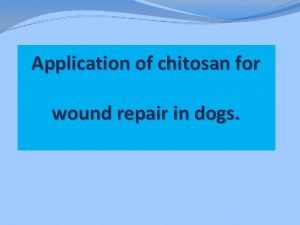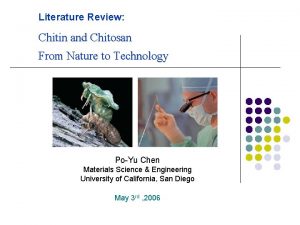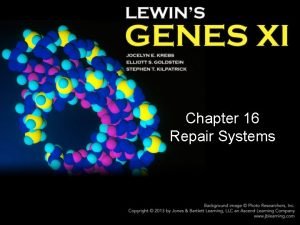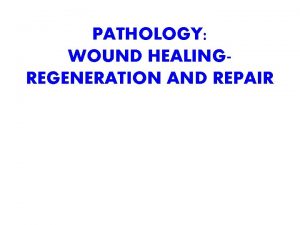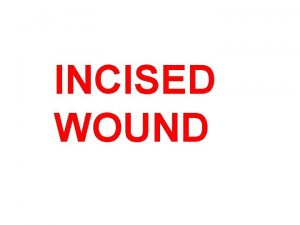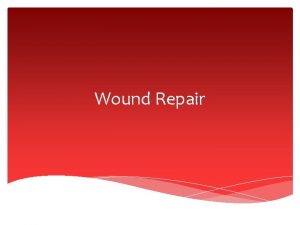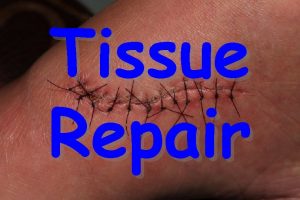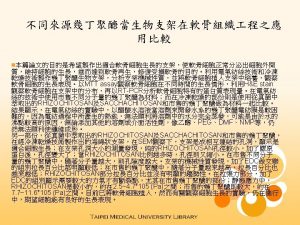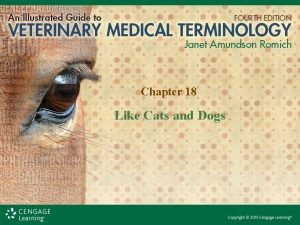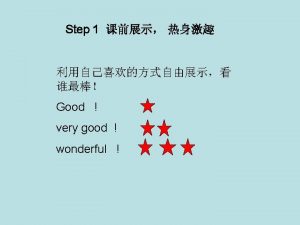Application of chitosan for wound repair in dogs



















- Slides: 19

Application of chitosan for wound repair in dogs.

Introduction The repair of an epithelial wound is merely a normal physiological process. Wound healing depends on elimination of any source of infection and regeneration of the lost layers (Muzzarelli, 2009) The majority of wounds heal without any complications, other types are chronic and resist the normal repair.

One of the new products widely used in the medical field is: Chitosan a water soluble and a bioadhesive product extracted primarily from shell fish sources

More than 40 years have elapsed since this biopolymer had aroused the interest of the scientific community around the world for its potential biomedical applications (Jarmila and Vavríková, 2011). Chitosan helps in faster wound healing and scar prevention.

It stimulates cell proliferation and tissue organization. It gradually depolymerizes to release Nacetyl-b-D-glucosamine, which initiates fibroblast proliferation and helps in ordered collagen deposition, stimulating increased level of natural hyaluronic acid synthesis at the wound site. Chitosan derivatives have also an antimicrobial, antitumor and antioxidant activities.

Aim of work The aim of the present work was to study the effect of topical application of chitosan on full thickness skin wound regeneration and to evaluate its efficacy as an accelerator in wound repair.

Material and Methods This experimental work was carried out on 12 experimental apparently healthy male mongrel dogs of nearly the same age and weight. The animals were divided into 4 groups each group consisted of 3 animals. Aseptic preparation for the intended surgical fields and two full-thickness equal 10 cm longitudinal skin incisions were created on each dog's both side at the dorsal aspect of the animal.

An experimentally incised wound , showing topical application of chitosan powder.

In each dog, one wound ( left side) was treated with chitosan powder and the other wound (right side) washed by saline solution and considered as a control. Chitosan powder was repeatedly applied on the wounded areas (one application per day)

group I 1 weeks II 2 weeks group III 3 weeks IV 4 weeks

Examined clinical parameters included measuring the wound length, examination of the wound for the presence or absence of infection and progress of healing process. full thickness specimen were taken from each wound site including surrounding tissues for histopathological examination to evaluate the process of wound healing.

Results Clinical observation of the treated and control wounds indicated : hemostasis was clear directly after the topical application of chitosan.

One week postwounding the chitosan-dressed wounds had been healed more promptly as compared with the control wounds manifested by regular wound lips and the wound's depth diminished with minimal gap than in the control group.

Two weeks postwounding, notice the muscle layer healed in the chitosan group faster than in the control group

Three weeks postwounding : Treated wounds completely healed and covered by hair, Control wounds. healing and closure of the wounds was delayed with the presence of a small aperture.

` One week: Treated wounds showed a hyperactive fibroblastic proliferation (a), whereas, in control group, the pron massive infiltration with neutrophiles associated with haemorrhage ( b). At 2 weeks : angiogenesis was early in the treated with formation of new blood vessels, fibroblastsproliferation associated with infiltration with polymorphnuclear cells and macrophages ( c). control sections revealed epidermal and dermal necrosis associated with infiltration with neutrophiles and macrophages with fibroblasts proliferation (d). 3 weeks : granulation tissue was pronounced than in the control group, proliferation of epidermal cells with different mitotic figures ( e) as well as highly vascularized and organized subcutaneous granulation tissue

4 weeks: complete regeneration of epidermal cells with keratin layer similar to the normal skin (a). The fibroblast cells laid down a network of collagen fibers appearing as wavy collagen bundles surrounding the neovasculature of the wound ( b & c), In control group, examined sections revealed massive infiltration with polymorphnuclear cells, hyalinosis of subcutaneous granulation tissue (d) and haphazardly arranged collagen fibers (e). Fig. (7):

Conclusion In conclusion this study proved that the biomedical product chitosan is effective for tissue regeneration and showed better and faster tissue epithelization. As far as we can see, chitosan seemed to have no known side-effects and safe. Moreover, chitosan seems to be an excellent candidate dressing material for wound repair.

 Chitosan for dogs
Chitosan for dogs Chitin in nature
Chitin in nature Base excision repair vs mismatch repair
Base excision repair vs mismatch repair Base excision repair
Base excision repair Fspos vägledning för kontinuitetshantering
Fspos vägledning för kontinuitetshantering Myndigheten för delaktighet
Myndigheten för delaktighet Presentera för publik crossboss
Presentera för publik crossboss Kung som dog 1611
Kung som dog 1611 Mall debattartikel
Mall debattartikel Tobinskatten för och nackdelar
Tobinskatten för och nackdelar Tack för att ni har lyssnat
Tack för att ni har lyssnat Mall för referat
Mall för referat Sten karttecken
Sten karttecken Fimbrietratt
Fimbrietratt Shingelfrisyren
Shingelfrisyren Byggprocessen steg för steg
Byggprocessen steg för steg Rbk-mätning
Rbk-mätning Tryck formel
Tryck formel Uppställning multiplikation
Uppställning multiplikation Elektronik för barn
Elektronik för barn
